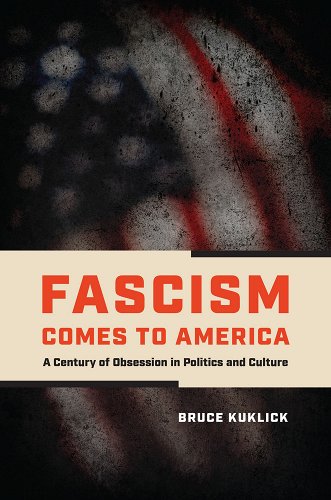Washington, IL. One might say of fascism what Justice Potter Stewart said of pornography: I know it when I see it. And judging by the chatter these days, people see it everywhere. On the right. On the left. In the center. In films. On billboards. On clothes. On college campuses. On social media. There are Jewish fascists, Islamic fascists, Christian fascists. Black fascists, white fascists, feminine fascists, gay fascists—even antifascist fascists! Perhaps never before has there been an ideology so wonderfully diverse and roundly despised. Presumably with little appreciation for the wonder of it all, MSNBC, over the course of the first ten months of 2022, “evoked fascism, or used the term ‘fascist,’ 1,614 times.” Such incessant evocations might lead one to believe that fascism menaces the world today much as it did some eight decades prior. But the dispassionate observer would search in vain to find a veritable fascist regime anywhere the world over.
This incongruity—between the utter absence of fascist regimes in the contemporary world and the pervasiveness of fascism in contemporary discourse—is brought to light in Bruce Kuklick’s new book, Fascism Comes to America. In 200-odd pages, Kuklick deftly chronicles America’s preoccupation with fascism over the past 100-odd years. Fascism’s time on the world stage was brief, having been all but booted from the stage a mere two and half decades after making its entrance onto it. “Yet,” as Kuklick notes, “fascism has remained alive in American imaginations long after its eclipse in 1945.” That it has done so is all the more curious when one considers the much less ballyhooed case of communism, which acquired state power around the same time fascism did but proved much more durable and formidable in the long run. Indeed, while one cannot locate a fascist state on an extant map, one would have no trouble identifying a communist one. What is more, while fascists in America have never been more than a fringe element, communists have at times signified a sizable and in some circles respectable contingent. To hammer (and sickle) the point home further, among Millennials and Gen Zers, what swells is not support for fascism, but communism.
While Kuklick alludes to this curiosity, he does little to address it. As he summarily asserts early on, “there is no good answer to the question, Why Fascism?” It is hard not to read this as an evasion of sorts, one that clouds the work as a whole. The chief strength of the book is in many ways its chief weakness. Kuklick provides an exhaustive—and at times, exhausting—account of the “history of the concept of fascism” in America, while eschewing any meaningful analysis of the concept itself. The result can read like a litany of name-calling, one that might be likened to a survey, not of the who’s who of fascism, but of who called whom fascist.
What the reader stands to gain from this book is an appreciation of just how haphazardly the term has been bandied about and with it, an appreciation not only for the term’s ubiquity, but its vacuity as well. After a brief period during which the ideology enjoyed legitimacy and appeal, fascism fell from grace more precipitously than it rose to power. That appeal materialized in the aftermath of the Great War (which shattered the liberal faith in progress that had steadily gathered steam over the century-long Pax Britannica) and was reinforced during the Great Depression (when capitalism appeared to have run its course). In this time of uncertainty and upheaval, some saw in fascism a viable and desirable path forward, particularly desirable in the eyes of those who were repulsed by the other non-liberal contender in the political arena: communism. But Mussolini’s increasingly authoritarian tactics unsettled those in America who otherwise might have supported his policies, and when Il Duce hitched his wagon to the Fuhrer, fascism’s fate was effectively sealed. After the Second World War, fascism had become almost exclusively a term of opprobrium used to vilify and invalidate those to whom it was applied.
And seemingly it was applied to anyone and everyone. Franklin Roosevelt, who “affront[ed] hallowed precedents” (e.g., by violating the two-term limit and attempting to pack the court), was a fascist, as were, by association, New Deal Democrats. McCarthyism, which was tantamount to fascism (in Truman’s eyes, no different from Hitlerism), reaffirmed the conviction that the natural home of fascism was on the right, but Lyndon Johnson’s escalation of the war in Vietnam “untethered fascism from the right.” (As Senator Robert Kennedy rhetorically asked a group of students: “Don’t you understand that what we are doing to the Vietnamese is not very different from what Hitler did to the Jews?”) Nixon’s fascism was too plain for dispute, and if Reagan’s fascism was less apparent, it was palpable enough for parallels between Hitler and the Gipper to be drawn.
Part of the merit of Kuklick’s approach is that it ranges far and wide beyond the realm of politics to examine America’s fascination with fascism as reflected in areas such as literature, film, and the academy (of academicians, not of Motion Picture Arts and Sciences). From Sinclair Lewis’s It Can’t Happen Here (1935) and Charlie Chaplin’s The Great Dictator (1940) to Philip Roth’s The Plot Against America (2004) and Amazon’s hit series The Man in the High Castle (2015-19), fascist themes and foes have consistently found an audience and struck a nerve. Scholars likewise have discovered in fascism an inexhaustible well from which to draw. The seminal works of the twentieth century devoted to the topic, such as On the Origin of Totalitarianism (Hannah Arendt) and The Authoritarian Personality (Theodor Adorno, et. al.), appear lost at sea amidst the endless outpourings of twenty-first century commentators. Again, what is striking is the enduring fixation with an ideology that has, as a real-world variant, not proved at all enduring.
A specter is haunting America—the specter of fascism. There is something absurd about the fear that this spectral peril continues to inspire in the American people. Fascism no doubt is a real-world phenomenon, but in stretching its meaning to the point of incoherence, one finds that fascism is everywhere and nowhere. If everyone is a fascist, then no one is a fascist. In a land of giants, there are no giants. The utter vacuousness of the term is made risibly obvious when it is applied anachronistically. Anachronisms, of course, can be appositely applied. For example, it is fitting to refer to Ancient Greek science, even though, strictly speaking, science is a modern category that has no exact equivalent in Ancient Greece. But fascism is a different matter. Part of the problem is that fascism is very much a reaction to and repudiation of liberalism and its ideological derivations. To speak of fascism before liberalism would be akin to speaking of anti-colonialism before colonialism. But that aside, the mindlessness of the anachronistic approach—and of the (mis)usage of fascism more broadly—is laid bare by the suggestion that George Washington was “an instigator of [fascism].” If the man who willingly and even eagerly ceded command of the Continental Army and the presidency was a proto-fascist, then what manner of man could evade the charge?
What precisely is one to take away from all this? Kuklick does not make it entirely evident. At a minimum, the book provides the reader with a much broader understanding of the history of the idea of fascism in American history. The implicit lesson in this is that the term has been rendered more or less meaningless. Kuklick announces as much at the outset, acknowledging that the word has been reduced to little more than an epithet. But oddly obtuse would be the reader who picked up this book without already knowing as much. When Biden called Trump supporters semi-fascists, perhaps the only thing that was clear about his utterance was that it was meant to be deprecatory.
It is perhaps unfair to be critical of a work for not being what its author never intended it to be, but America would be served better by a book that aimed to correct the misuse of fascism rather than merely chronicle it. Fascism is not whatever one makes of it. There is a reason why there cannot be libertarian or Amish fascists. The central tenets of fascism are irreconcilable with and antagonistic to those of libertarianism and Anabaptism. On this score, suffice it to mention fascism’s commitment to statism and exaltation of violence, which are integral to the ideology and not some incidental aspects of it. This is why the unremitting claims that Trump is a fascist ring so hollow. What fascist spends his time in power reducing the size of the state and scaling back its international military ambitions? To those who would adduce January 6th as proof of Trump’s fascism, what fascist instructs his seditious minions to remain peaceful and be respectful to law enforcement and, moreover, offers to provide troops in advance of the coup he is planning to carry out to forestall violence rather than unleash it? The answer is a fascist neither worth his salt nor the designation.
Kuklick, to his credit, recognizes as much. He avers that Trump “vehemently defended the Jewish State of Israel against its Middle Eastern Enemies;” preferred isolationism to internationalism and military expansionism; domestically advanced “policies [that] often sponsored federalism” rather than nationalism; protected the Second Amendment and allowed the privileges of the First to “explode” (far more often than not to his considerable disadvantage). None of this, writes Kuklick, is consistent with what “fascism in Germany had originally stood for,” which is true, but also needlessly equivocal. It would have been more judicious to leave it at, none of this is consistent with fascism—period. While the racialist and anti-Semitic element was Hitler’s distinctive contribution to the ideology, fascism by its very nature favors the aggrandizement of the state and opposes the liberties of the individual, those of speech and press not least among them. By claiming that Trump’s actions and policies were inconsistent with German fascism, Kuklick at least intimates that they might be consistent with some other form of fascism, and in doing so, does more to perpetuate America’s pernicious obsession with fascism than redress it.
That obsession, as Kuklick notes, has only gotten worse with time. Whereas scholars and historians who wrote in the immediate aftermath of the rise and fall of fascism were reluctant to apply the appellation (Richard Hofstadter, for example, “refrained from calling the populists [of his day] fascists” and thought “it would be a great mistake” to do so), pundits and pedants today exhibit no qualms about using the f-word. (Kuklick mentions Madeline Albright’s Fascism: A Warning (2018) as an illustration of this. Other prominent and maybe more apropos examples would include the recent musings of Timothy Snyder, Jason Stanley, and Robert O. Paxton, all of whom are, like Hofstadter before, public intellectuals.) Obsessions are, as a rule, unhealthy, and while some might rightly be considered innocuous, America’s abiding and growing obsession with fascism cannot be counted one of them.
Though Kuklick elects not to define fascism, he maintains that the word is not “devoid of meaning or a vacuous signifier.” Its significance is that it amounts to a “reproof,” one that stigmatizes and “expresses loathing more than it identifies a reality.” To label someone a fascist is to delegitimize if not demonize that person, on par with calling someone a racist. In the popular mind, it sanctions behavior directed at people denominated thus that otherwise would be unsanctionable. One can say and do things to racists and fascists that cannot rightfully be said or done to decent denizens or even everyday deviants (provided they deviate in the right direction). No doubt racists and fascists exist, but the reckless disregard with which those words are pronounced ensures that plenty of people who do not merit the indictment and the mistreatment that comes with it will be unjustly subject to both.
What should be done about the perversion of this word and the aspersions it invites? It is naïve to suggest that America’s fate depends on a spirit of mutual concord. Indeed, the republic was designed to withstand the discord that is, per the Framers’ view, part and parcel of politics and human nature more deeply. But if the Madisonian republic does not demand that its citizens hold hands, its success does depend on their ability to compromise with one another, which itself presupposes an ability to communicate with one another. That spirit of compromise and deliberation is in woefully short supply of late and seems to be declining steadily by the day. The problem is not simply mutual disdain, but mutual misunderstanding. After all, adversarial parties have constructive debates all the time. But when the terms of the debate cannot be settled upon, meaningful dialogue is all but foreclosed.
The gender wars, which will rage on so long as its combatants cannot agree on what a woman is, is a telling attestation of this. The pseudo war against fascism is another. Kuklick may decline to dispel confusion on this score, but in documenting America’s century-long obsession with fascism, he exposes the extent to which the term has been heedlessly tossed about and, in the process, emptied of meaning. The reader may be none the wiser regarding the definition of fascism, but this book affords a wisdom and moderation of sorts all the same, one that stems from the awareness that in popular rhetoric, fascism is a word full of sound and fury, signifying not much.






1 comment
Benjamin David Steele
If you look at the research and analysis of historical fascism, it is clearly and precisely defined. I won’t bother to point out many of the defining traits here because it’s more work than I want to do. But let it be clear that it isn’t a vague concept that can apply to just anything, despite how often it is misused and abused as a dismissive slur.
Comments are closed.